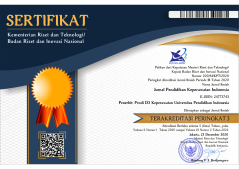LOST TO FOLLOW-UP : REASONS AND TRUE OUTCOME FOR PATIENTS ON ARV TREATMENT IN TERATAI CLINIC BANDUNG INDONESIA
Abstract
Klinik RSHS Teratai HIV telah merawat pasien dari September 2004 sampai Desember 2009, sebanyak 2.060 ODHA dan 1290 menerima ARV (63%). Selama periode ini, sebesar 11% (141 orang) kehilangan kontak lebih tinggi dari keseluruhan persentase di Indonesia yaitu 10,7% (Depkes, 2009). Tujuan dari penelitian ini adalah untuk menyelidiki hasil yang benar dan faktor hilang tindak lanjut ARV di klinik RSHS Teratai ARV. Penelitian ini menggunakan metode wawancara mendalam dengan 25 pasien HIV / AIDS bawah pengobatan ARV di klinik Teratai RSHS dan mangkir sejak tahun 2009 yang tinggal di daerah Bandung. Informan dipilih secara acak dan dihubungi untuk kunjungan rumah untuk diwawancarai oleh pewawancara yang berpengalaman. Peneliti melakukan wawancara mendalam di rumah pasien sekitar 60 menit. Data direkam oleh pita digital direkam, ditranskrip dan dicetak oleh dua peneliti bidang independen menggunakan analisis tematik.Hasil penelitian ini menunjukkan tujuh tema yang pengetahuan yang tidak benar, optimisme yang tidak realistis, masalah aadministratif, perasaan efek samping negatif, masalah interpersonal, masalah kecanduan, dan kurangnya perawatan diri. Oleh karena itu, penting untuk mengembangkan tindakan pencegahan melalui rincian kontak pasien, meminta pasien persetujuan untuk dihubungi, telepon, kunjungan rumah setelah 3 minggu kehilangan kontak, dan menyarankan pasien untuk mendaftar ke klinik ART lebih dekat dengan rumah mereka , dan mengembangkan sistem reminder untuk mengingatkan pasien untuk mengambil ARV tepat waktu.
ABSTRACT
Teratai clinic HIV RSHS has treated patients from September 2004 to December 2009, as much as 2060 PLWHA and 1290 receive ARV (63%). Over this period, 11% (141) were lost to follow-up that is higher than overall lost to follow up percentage in Indonesia which is 10.7% (MOH annually report December 2009). The aim of this study was to investigate the true outcomes and factors of lost follow up to ARV. This study used indepth interview method to 25 HIV/AIDS patients under ARV treatment in the Teratai clinic RSHS and lost to follow up since 2009 who lived in Bandung area. Informants were randomly selected and contacted for a home visit to be interviewed by experienced interviewer. The interviewers obtained verbal informed consent and conducted an in depth interview in the patients home. Interview took about 60 minutes. Data were recorded by digital tape recorded, transcribed and scored by two field researchers independently using thematic analysis. The result of this study shows seven themes which are incorrect knowledge, unrealistic optimism, administrative problems, feeling of negative side effect, interpersonal problem, addiction problem, and lack of self-care. Therefore, it is important to develop preventive measure through up-dating patients’ contact details, ask patients consent to be contacted, up date phone contact, home visit after 3 weeks lost of contact, advice patients to register to ART clinic closer to their homes, and develop a reminding system to remind patients to take ARV on time.
Keywords
Full Text:
PDFReferences
Chenard C (2007). The Impact of Stigma on self-care Behaviour of HIV-positive gay men striving for normalcy. Journal of the Association of Nurses in AIDS Care;18(3):23-32.
Geng EH, Bangsberg DR, Musinguzi N, Emenyonu N, Bwana MB,
Yiannoutsos CT, et al (2009). Understanding Reasons for and Outcomes of Patients Lost to Follow-Up in Antiretroviral Therapy Programs in Africa Through a Sampling-Based Approach. J Acquir Immune Defic Syndr 2009,53:405-411
Chou F and Holzemer (2004). Linking HIV/AIDS Client’s self care outcomes. Journal of the association of Nurses in AIDS care ;15(4):58-67.
Choksawadphinyo K (2005). Behaviors and barriers to self-care in people living with HIV/AIDS: Finding from a qualitative study in Northern Thailand .Asian Journal of Nursing; 8(3):31-38.
Country report on the Follow-up to the Declaration of Commitment on HIV/AIDS reporting period 2006-2007 UNGASS, National Aids
Commission Republic of Indonesia, Jakarta 2008, Ref Type: Report
Directorate General CDC&EH Ministry of Health, 2003
Directorate General CDC&EH Ministry of Health, 2008. MOH annual report
Directorate General CDC&EH Ministry of Health .2009. MOH annual report.
Flannelly LT & Jillian I (2001). Relationship of religion, health status and socioeconomic status to the quality of life of individuals who are HIV positive. Issue in Mental Health Nursing; 22(3):253-27
Leenerts MH and Magilvy JK (1998). Investing in Self-care: Grounded in the lived experience of low-income VIV positive white women. Advanced Nursing Science; 22(3):58-75
Micek M A, Gimbel-Sherr K, Baptista AJ, Matediana E, Montoya P, Pfeiffer J, Melo A, Gimbel-Sherr S, Johnson W, and Gloyd S. (2009). Loss to Follow-Up of Adults in Public HIV Care Systems in Central
Mozambique: Identifying Obstacles to Treatment. J Acquir Immune Defic Syndr 2009;52:397–405.
Nachega, JB; Mugavero, MJ, Zeier, M; Vitória, M, Gallant, JE. 2011. Treatment simplification in HIV-infected adults as a strategy to prevent toxicity, improve adherence,quality of life and decrease healthcare costs. Patient Preference and Adherence 2011:5 357–367
National AIDS Committee (2008). Data Kasus 2005 – 2008. Available at: http://www.aidsindonesia.or.id/index.php?option=com_content&task=view&id=1611&Itemid=124
Pisani E, Dadun, Sucahya PK, Kamil O, Jazan S. Sexual behavior among injection drug users in 3 Indonesian cities carries a high potential for HIV spread to non-injectors. (2003) J Acquire Immune Defic Syndr 2003; 34(4):403-406.
Riley T, Lewis BM, Lewis JF (2007). Low-income HIV-Infected women and Process of engaging in Healthy Behaviour. Journal of the Association of Nurses in AIDS Care 2007; 19(1):3-15.
Siegel K and Krauss BJ (2002). Living with HIV Infection. Journal of Health Social behaviour ;32:17-32.
UNAIDS. Epidemiological fact sheets on HIV/AIDS and sexually transmitted infections-Indonesia. 2006. Ref Type: Report
UNAIDS. AIDS epidemic update. 2007. Geneva. Ref Type: Report
Weigel R, Hochgesang M, Brinkhof M, Hosseinipour MC, Boxshall M, Mhango E, Nkwazi B, Tweya H, Kamlaka M, Chagwera F, Phiri S. (2011). Outcomes and associated risk factors of patients traced after being lost to follow-up from antiretroviral treatment in Lilongwe, Malawi. BMC Infectious Diseases 2011, 11:31
Lumenta, B. (1997). Tanatologi tentang Perilaku Pasien Terminal. Ebers Papirus-Vol 3. No.1
Lonetto, R., & Templer, D. ( 1991). Death Anxiety. Washington: Hemisphere Publishing Corporation.
Monks. (2011). Psikologi Perkembangan. Yogyakarta: Gadjah Mada University Pres.
Ross, K. E. (2011). Death and Dying. New York: Simon and Schuste.
Smeltzer & Bare (2007). Brunner & Suddarth’s texbook of medical surgical nursing. Philadelphia: Lippincott Williams & Wilkins.
Sugiyono. (2014). Metode Penelitian Kuantitatif dan kuantitatif. Bandung: Alfabeta.
Yuliana. (2015). Mengatasi Kecemasan terhadap Kematian pada Pasien Sakit melalui Konseling Kelompok. Seminar Psikologi & Kemanusiaan , 458-463.
DOI: https://doi.org/10.17509/jpki.v3i1.7476
Refbacks
- There are currently no refbacks.
Jurnal Pendidikan Keperawatan Indonesia(JPKI) published by Indonesia University of Education. JPKI is licensed under a Creative Commons Attribution-ShareAlike 4.0 International License.
Office :
Nursing Department. FPOK UPI.
229, Dr. Setiabudhi Street. Bandung 40154
West Java , Indonesia
E-mail : jpki@upi.edu

_.png)
_.png)
_.png)











